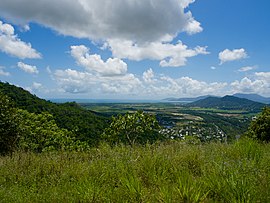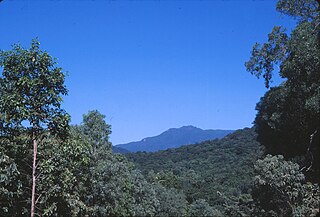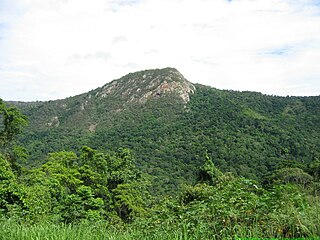
Barron Gorge National Park is a protected area in the Cairns Region, Queensland, Australia. It is predominantly within the locality of Barron Gorge.
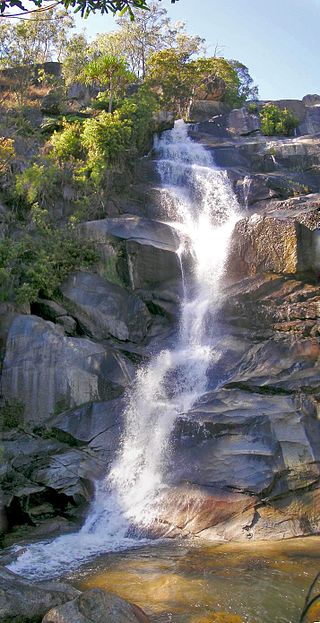
Davies Creek National Park is in Far North Queensland, Australia, 1,392 km northwest of Brisbane, 20 km south west of Cairns. The park is located on the Atherton Tableland within the Barron River water catchment. It lies within the Einasleigh Uplands and Wet Tropics of Queensland bioregions.
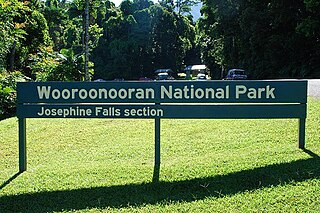
Wooroonooran National Park is a national park in Queensland, Australia, 1,367 km northwest of Brisbane, between Innisfail and Cairns.

Cairns is a city in Queensland, Australia, on the tropical north east coast of Far North Queensland. The population as of the Census 2021 was 169,312, having grown on average 1.02% annually over the preceding five years. The city is the 5th-most-populous in Queensland, and 15th in Australia.

The Wet Tropics of Queensland World Heritage Site consists of approximately 8,940 km2 of Australian wet tropical forests growing along the north-east Queensland portion of the Great Dividing Range. The Wet Tropics of Queensland meets all four of the criteria for natural heritage for selection as a World Heritage Site. World Heritage status was declared in 1988, and on 21 May 2007 the Wet Tropics were added to the Australian National Heritage List.

The Atherton Tableland is a fertile plateau, which is part of the Great Dividing Range in Queensland, Australia. It has very deep, rich basaltic soils and the main industry is agriculture. The principal river flowing across the plateau is the Barron River, which was dammed to form the irrigation reservoir named Lake Tinaroo.
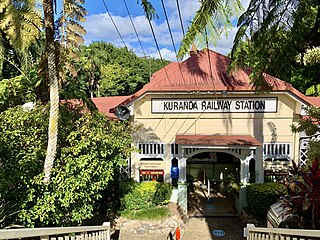
Kuranda is a rural town and locality on the Atherton Tableland in the Shire of Mareeba, Queensland, Australia. In the 2016 census, Kuranda had a population of 3,008 people. It is 25 kilometres (16 mi) from Cairns, via the Kuranda Range road. It is surrounded by tropical rainforest and adjacent to the Wet Tropics of Queensland World Heritage listed Barron Gorge National Park.

The Barron River is located on the Atherton Tablelands inland from Cairns in North Queensland, Australia. With its headwaters below Mount Hypipamee, the 165-kilometre (103 mi)-long river with a catchment area of approximately 2,138 square kilometres (825 sq mi) forms through run off from the Mount Hypipamee National Park, flows through Lake Tinaroo, and eventually empties into the Coral Sea near Smithfield.

The Bunya Mountains are a distinctive set of peaks forming an isolated section of the Great Dividing Range in southern Queensland. The mountain range forms the northern edge of the Darling Downs in the locality also called Bunya Mountains near Bell and Dalby. The mountains are south of Kingaroy and just to the south west of Nanango. The range is the remains of a shield volcano which was built from numerous basalt lava flows about 23-24 million years ago.

Barron Falls is a steep tiered cascade waterfall in Kuranda, Shire of Mareeba, Queensland, Australia. The falls are created by the Barron River descending from the Atherton Tablelands to the Cairns coastal plain.

The Djabugay people are a group of Australian Aboriginal people who are the original inhabitants of mountains, gorges, lands and waters of a richly forested part of the Great Dividing Range including the Barron Gorge and surrounding areas within the Wet Tropics of Queensland.
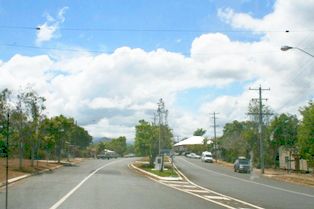
Mount Molloy is a rural town and locality in the Shire of Mareeba, Queensland, Australia. It is a historic mining and timber town, 55 kilometres (34 mi) north of Cairns. The dominant industry in the area is cattle grazing; the town itself consists of a few shops and an old hotel.

The Kuranda Scenic Railway is a tourist railway service that operates along the heritage-listed Cairns-to-Kuranda railway line. Constructed in 1891, the line runs from Cairns, Queensland, over the Great Dividing Range to the town of Kuranda on the Atherton Tableland. Along the way, the route passes through the Macalister Range, as well as the suburbs of Stratford, Freshwater and Redlynch. Along the way, the train also stops at a lookout, which provides views of Barron Falls.

The Kuranda Range road is an informally named section of the Kennedy Highway in Queensland, Australia. The road traverses the Macalister Range near Cairns. The 11.5 kilometres (7.1 mi) section of road connects Smithfield, a suburb of Cairns in the Cairns Region with Kuranda, a town in the Shire of Mareeba on the Atherton Tableland, at an altitude of about 360 metres (1,180 ft). Traffic is primarily limited to one lane each way, with overtaking lanes at various points. The Kuranda Skyrail cableway crosses the road twice. Henry Ross Lookout is located near the road's highest point, at an altitude of 430 metres (1,410 ft), and is named after the foreman in charge of building the road to cross the range in 1939.

The Wooroonooran Important Bird Area comprises some 5125 km2 of mainly forested land in the Wet Tropics of Queensland World Heritage Site, of Far North Queensland, Australia.

The Cairns-to-Kuranda Railway is a heritage-listed railway line from the Cairns Region to the Shire of Mareeba, both in Queensland, Australia. It commences at Redlynch, a suburb of Cairns and travels up the Great Dividing Range to Kuranda within the Shire of Mareeba on the Atherton Tableland. It was built from 1913 to 1915 by Queensland Railways. Components of it include Stoney Creek Bridge, the Rail Bridge over Christmas Creek, Kuranda railway station, and Surprise Creek Rail Bridge. It was added to the Queensland Heritage Register on 21 August 1992. The railway is used to operate a tourist rail service, the Kuranda Scenic Railway. It forms part of the Tablelands railway line.
Mowbray is a coastal locality in the Shire of Douglas, Queensland, Australia. In the 2016 census, Mowbray had a population of 321 people.

Barron Gorge is a rural locality in the Cairns Region, Queensland, Australia. In the 2016 census Barron Gorge had a population of 0 people.

Macalister Range is a coastal locality in the Cairns Region, Queensland, Australia. In the 2016 census, Maclister Range had no population.
